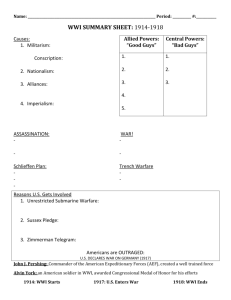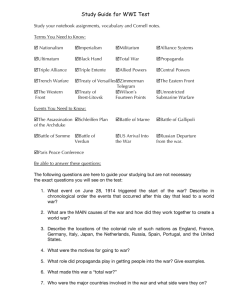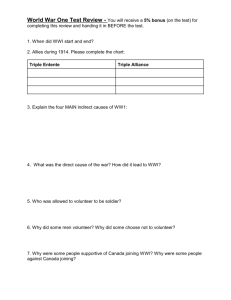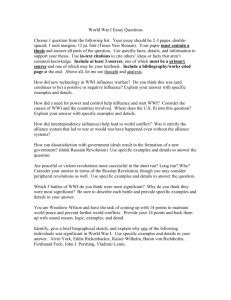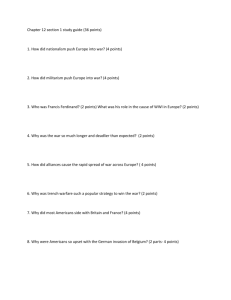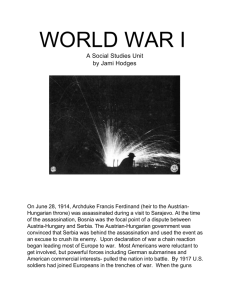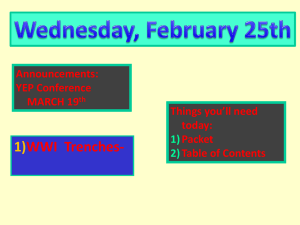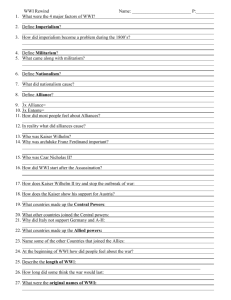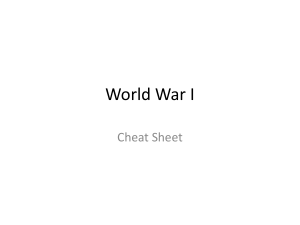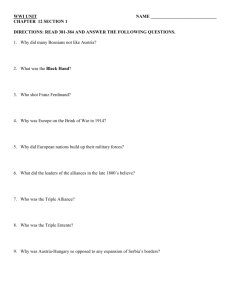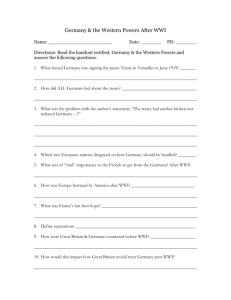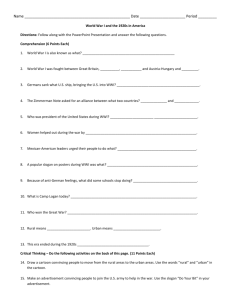Unit Plan for Grade 8 WWI
advertisement
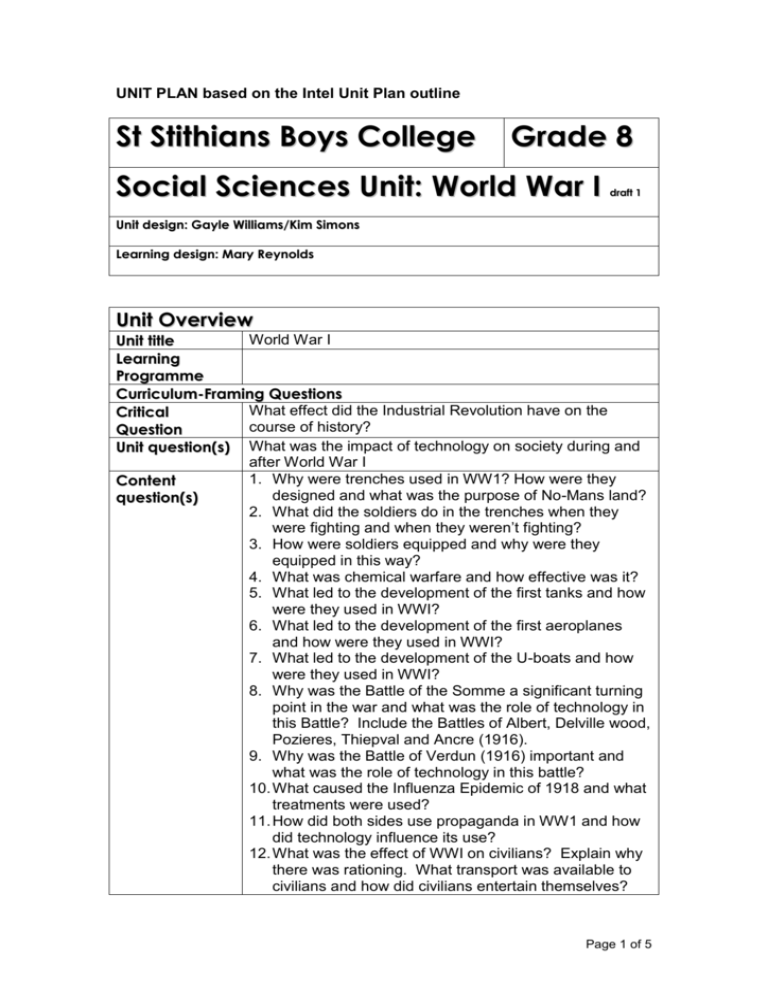
UNIT PLAN based on the Intel Unit Plan outline St Stithians Boys College Grade 8 Social Sciences Unit: World War I draft 1 Unit design: Gayle Williams/Kim Simons Learning design: Mary Reynolds Unit Overview World War I Unit title Learning Programme Curriculum-Framing Questions What effect did the Industrial Revolution have on the Critical course of history? Question Unit question(s) What was the impact of technology on society during and after World War I 1. Why were trenches used in WW1? How were they Content designed and what was the purpose of No-Mans land? question(s) 2. What did the soldiers do in the trenches when they were fighting and when they weren’t fighting? 3. How were soldiers equipped and why were they equipped in this way? 4. What was chemical warfare and how effective was it? 5. What led to the development of the first tanks and how were they used in WWI? 6. What led to the development of the first aeroplanes and how were they used in WWI? 7. What led to the development of the U-boats and how were they used in WWI? 8. Why was the Battle of the Somme a significant turning point in the war and what was the role of technology in this Battle? Include the Battles of Albert, Delville wood, Pozieres, Thiepval and Ancre (1916). 9. Why was the Battle of Verdun (1916) important and what was the role of technology in this battle? 10. What caused the Influenza Epidemic of 1918 and what treatments were used? 11. How did both sides use propaganda in WW1 and how did technology influence its use? 12. What was the effect of WWI on civilians? Explain why there was rationing. What transport was available to civilians and how did civilians entertain themselves? Page 1 of 5 13. The Lusitania was one of the largest losses of WWI. Why? 14. Why and how were Zeppelins developed? 15. What characterized the battleships used in WWI and how did they influence the progress of the war? Critical Outcomes Identify and solve problems Work effectively with others Communicate effectively Demonstrate an understanding of the world as a set of related problems Organise and manage oneself to meet deadlines Participate as a responsible citizen of the world Collect, analyse, organise and critically evaluate information Use science and technology effectively and critically Reflect on and explore a variety of strategies to learn more effectively. Be culturally and aesthetically sensitive Explore education and career opportunities. Develop entrepreneurial skills Learner Assessment Outcomes to be assessed Assessment 1. Historical Enquiry: The learner is able to use enquiry skills to investigate the past and present. 2. Historical Knowledge and Understanding: The learner is able to demonstrate historical knowledge and understanding. 3. Historical Interpretation: The learner is able to interpret aspects of history. Rubric attached Incentive: Task or How will I achieve the set outcomes? Progress check: & date: 1. Choose a partner to work with. 2. Select ONE of the content questions above and register your choice with your teacher. 3. You will be given 2 x 55 minute class periods in the Library for research. The rest of the research must be done as homework. 4. Break your chosen topic into smaller questions using the Who? What? Where? When? Why? and How? Question words. 5. Use the resources provided in the Library (printed and A/V materials) and Global Resource Centre (Internet sites) to answer your questions. Page 2 of 5 6. Presentation: a. Prepare a poster, OHP transparencies, a model or other form of VISUAL presentation b. Present your VISUAL presentation as an ORAL report to the class. 7. Hand in a properly constructed bibliography of the sources that you have used. 8. Points to note: a. Make sure that you cover the most important facts on your topic in your presentation. b. Make sure that your presentation covers YOUR topic only. c. Your presentation will be interesting to the class if you take an interest in your work. Think about what you would like to hear and how you would like to hear it. Deadlines: All visual presentations must be completed by XXXX. Oral presentations will be completed in the week beginning XXX Approximate time needed Research: 2 x 55 minute lessons in the Library + 4 weeks of homework Presentation: 2 x 55 minute lessons for ORAL presentations What learning should be in place? 1. 2. 3. 4. Understanding of the origins and causes of WWI from class lessons Basic research skills Compiling a bibliography Oral presentation skills (explaining and elaborating on the information in the visual presentation) Materials and resources Technology: Camera Overhead Projector VCR Computer(s) Printer Scanner Internet Connection Television Other: Database/Spreadsheet Image Processing Web Page Development Desktop Publishing Internet Web Browser Word Processing E-mail Software Presentation software Other: Technology – Software: Page 3 of 5 Printed Materials Printed resources: 940.4 World War I books Magazine articles, newspaper cuttings and maps are on the project shelves in the Library Audio Visual Materials A number of videos on World War I are available at the Library desk on request. You may watch them in the Library after school Supplies: Project sheet, bibliography notes (also in GRC) Internet Resources: Web sites in GRC/History (These can be accessed from school or home www.stithian.com) Accommodations: This task is designed to accommodate a variety of learning styles and levels. English 2nd Language: Glossary of terms attached Extension: Depth of investigation is unlimited Create a website on your topic Keywords: Glossary Chemical warfare: warfare using poison gas and other chemicals Civilian: a person not in the army Epidemic: a widespread occurrence of a disease in a community at a particular time Industrial Revolution: the rapid development of a nation’s industry (especially in Britain in the late 18th and early 19th centuries) Influenza: a highly contagious virus infection causing fever and severe aching, often occurs in epidemics Propaganda: an organized programme of publicity, selected information etc used to propagate (or spread) a particular set of ideas or information Ration: a fixed official allowance of food, clothing etc in a time of shortage Technology: the study or use of the mechanical arts and applied sciences (i.e. man made things) U-boats Unterseebote or German submarines Page 4 of 5 Zeppelin: a large German dirigible (capable of being guided) airship of the early 20th Century, originally for military use Presentation Tips: Oral presentation: A common misconception is the notion of "making a speech" in class. It is far more likely that an informal oral demonstration or explanation is required. You will need to make a speech if you are taking part in the Public Speaking competitions, if you making a presentation in Chapel or if you are the Headmaster! An informal oral demonstration or explanation consists of more factual information or ideas that are presented in a logical sequence with discussion. Use a summary on an OHP transparency or in a Power Point format for an informal presentation. In this way your audience as well as you can follow your sequence and plan. Know beforehand what you are going to say. Use your summary as a guide. Use informal language IN YOUR OWN WORDS. Visual presentation: A visual presentation is a way of communicating linked ideas logically using visual images and appropriate annotations. The order in which you set out your pictures, how you caption them, the title and sub-headings that you use are all important to the effectiveness of your presentation. The layout itself should also be balanced and make use of fonts and fontsizes that can be seen clearly from a distance. However, without substance based on good research, a visually pleasing presentation is worthless. Make sure you do your research thoroughly BEFORE you put your presentation together. Page 5 of 5
